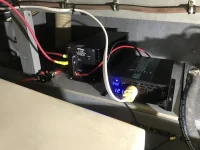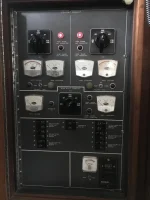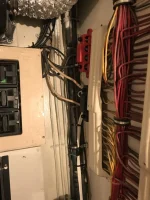oscarvan
Legendary Member
- Joined
- Oct 31, 2015
- Messages
- 2,926
- Status
- OTHER
- Hatteras Model
- Not Currently A Hatteras Owner
Eventually the SB side will convert to 24V, and as components need replacing they will be moved from 32V to 24V (The phased in approach). In the meantime, not wanting to run the Genny unless needing Air Conditioning I wanted some form of inverter to power the fridge when on the hook, and the 12V battery charger for the instruments when underway. Not to mention the plethora of personal electronic devices that need to be charged.
So after replacing the Port 32V bank with the snazzy Rolls batteries I installed a Newmar 32VDC to 24VDC converter to power a 24V 1500W inverter. The converter is limited to 40A continuous which gives me 960W. Just about enough to do what I need to do. Built a shelf in the generator room outboard of the battery bank. Yes, there is the Outback 32V inverter, but that puppy is $1800 and will be obsolete when the 32V to 24V conversion is complete.
After figuring out the supply schematics (in that other thread) I disconnected the 110V/50A feeds from the fuse box and tied the inverter into them. No surgery whatsoever upstairs needed. I will add a 10A AC ammeter in there to manage the load. I'll put that by the tie in/battery charger in the SB engine room.
Picture shows Port 110V/50A selected on S1 and S2..... the iights even work...... I will re-label the switch.
So after replacing the Port 32V bank with the snazzy Rolls batteries I installed a Newmar 32VDC to 24VDC converter to power a 24V 1500W inverter. The converter is limited to 40A continuous which gives me 960W. Just about enough to do what I need to do. Built a shelf in the generator room outboard of the battery bank. Yes, there is the Outback 32V inverter, but that puppy is $1800 and will be obsolete when the 32V to 24V conversion is complete.
After figuring out the supply schematics (in that other thread) I disconnected the 110V/50A feeds from the fuse box and tied the inverter into them. No surgery whatsoever upstairs needed. I will add a 10A AC ammeter in there to manage the load. I'll put that by the tie in/battery charger in the SB engine room.
Picture shows Port 110V/50A selected on S1 and S2..... the iights even work...... I will re-label the switch.
Attachments
Last edited:





